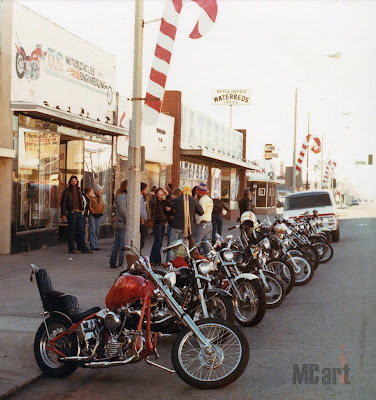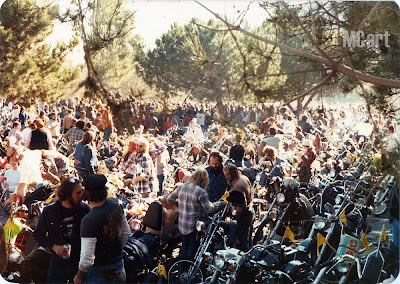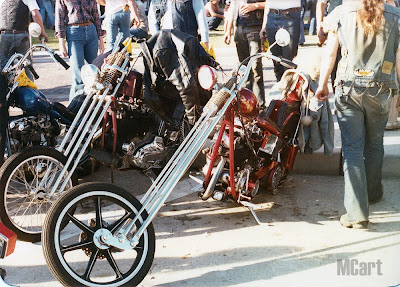
I found an interesting little book the other day; 'Sweet Dreams, the Life and Work of Rex McCandless' by Gordon Small (Ulster Folk and Transport Museum, 1987). Rex and his brother Cromie were responsible for the creation of the infamous 'Featherbed' Norton frame, among quite a few other innovative designs, regardless of the fact that he left school just after his 13th birthday, and had taken no courses in engineering.
"
I never had any formal training. I came to believe that it stops people from thinking for themselves. I read many books on technical subjects, but always regarded that as second-hand knowledge. I did my best working in my own way."

Always a motorcycle enthusiast, he began to tune his own machines, and by 1940, had a new Triumph Tiger 100, which was faster than a factory-tuned bronze-head T100 of his friend, Artie Bell (future Norton Works racer). He won the Irish 500cc Road Race and Hillclimb championships that year, even though he felt his brother Cromie to be the better rider. In the '49 Ulster GP, he was the first privateer home, in 6th place (see pic above of Rex, left, and Artie Bell).
Yet he found that his Triumph racer was often making unreasonable demands of its rider, and began experimenting with weight distribution. "
I had noticed that when I removed weight in the shape of a heavy steel mudguard anda headlight, that the bike steered a lot better. It made me think about things which swivelled when steering. I was in an area about which I knew nothing, but set-to to find out. It seemed obvious to me that th erigidity of the frame was of paramount importance. That the wheels would stay in line, in the direction the rider ointed the bicycle, regardless of whethr it was cranked over for a corner, and to resist the bumps on the road attempting to deflect it.Of equal importance was that the wheels would stay in contact with the road. That may seem obvious, but fast motor cycles than bounced all over the place. I decided that soft springing, properly and consistently damped, was required."
The first test-bed for Rex's ideas, built in 1944, was named the '
Benial' (Irish for 'beast' - see above). In general layout, it looked much like the double-loop frame used on the Gilera-Rondine watercooled dohc 4-cyl racer of the 1930's, but it had a proper swingarm at the back with vertical hydraulic shock absorbers (from a Citroen car). More contemporary viewers will see a direct lineage to the Seeley frame, and of course, many of the best Italian and Japanese space-frames from the 1980's. "
The Benial
was the best-handling bicycle I ever made."

Using the ideas garnered from his experiments, McCandless first designed a bolt-on rear suspension kit for rigid-frame motorcycles (see above), which was tested publicly by and Irish grass-track racing team at Brands Hatch in 1946. Prior to the race, other riders looked askance at the rear suspension kits, but after the race, they clamored for them. Rex had no ambition to go into manufacturing, and sold the rights to Feridax (pic below - Rex discussing his conversion with Stanley Woods).

Rex made friends with Freddie Dixon, famous as a tuner and rider/driver (for Douglas and Riley), and they were entreated by fellow Irishman Ernie Lyons to sort out the Triumph Grand Prix he had bought for the 1946 Manx GP. The Triumph as set up by the factory (I see a pattern here...) was lousy, but Rex and Freddie sorted it out, and Lyons famously won the race, even though his frame had broken (see pic below).
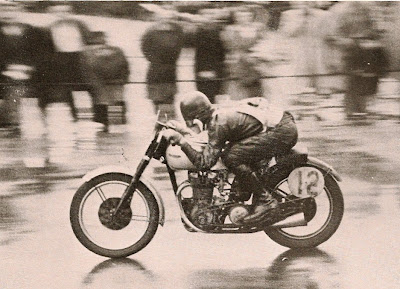
Norton was none too happy of course, as they were having problems of their own with their 'plunger' Garden Gate frame, which had a tendency to break, and handle like a camel. Joe Craig, in an effort to cure the cracks, kept making the frames heavier, with negative results (below; 1948 Works Norton).
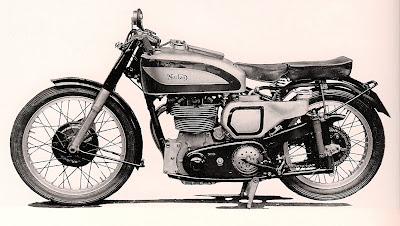
In McCandless' view, this showed an insufficient understanding of the stresses involved on the chassis, "...
all they did was to fix together bits of tube and some lugs.." In 1949, he told Gilbert Smith, the Managing Director of Norton, "
You are not Unapproachable, and you are not the World's Best Roadholder. I have a bicycle which is miles better!" The Norton brass set up a test on the Isle of Man, where a relative of Cromie McCandless' wife was Chief of Police. They closed the roads, "
Artie Bell was on my bike, ultimately christened the Featherbed by Harold Daniell. Geoff Duke was on a Garden Gate and both had Works engines. Gilbert Smith, Joe Craig and I stood on the outside of the corner at Kate's Cottage. We could hear them coming from about the 33rd [milestone]. When Geoff came through Kate's he was needing all the road. Artie rode around the outside of him on full bore, miles an hour faster, and in total control. That night Gilbert Smith and I had a good skinful."
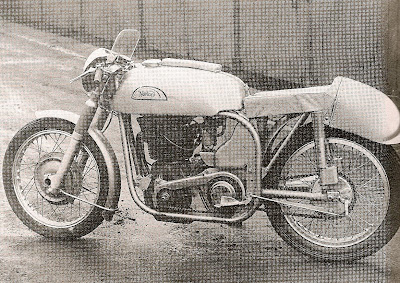
Further testing took place at Montlhery, with four riders (Bell, Duke, Daniell, and Johnny Lockett) going flat-out for two days. "
We went through two engines, then the snow came on. The frame hadn't broken so we all went home." The debut of the new frame came at Blandford Camp, Dorset, in April 1950, with Geoff Duke aboard (below, winning that race). The string of successes which followed gave a new lease on life to a 20-year-old engine design, and Norton won 1-2-3 in the Senior and Junior TT's that year.

Interestingly, Norton didn't have the facility to produce the Featherbed frame themselves, nor could Reynolds (the tubing mf'r), so Rex brought his own jigs over from Ireland, and personally built the Works Norton frames from 1950-53 (that original jig, as it exists today, can be seen in the pic below - what a historic piece of scrap iron!).

Rex McCandless was never an employee of Norton; he was paid by what worked - if an idea panned out, he was paid £1 per hour. If the idea didn't work, no charge.

By 1953, Rex could see that the writing was on the wall for the Manx engine, and pressed the factory to build a proper 4-cylinder racer, as Gilera and MV Agusta had done. "
Joe Craig was against the 4-cylinder project, and persuaded the Board that he could continue to extract enough power from the single." 
(pic below, Rex and Joe Craig).
As a stopgap measure
, Rex designed a new frame, more like the original Benial, with the dohc Norton engine vertical between lowered top rails. The petrol was carried in pannier tanks (see bottom pic), which allowed the rider to stretch out over the frame and behind full streamlining.
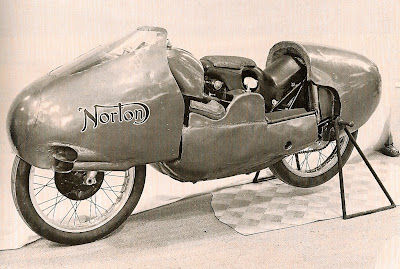
The bike was known as the Kneeler, and Ray Amm tried it out first in the North West 200 in 1953. It put up the fastest lap, with Amm calling it the most comfortable bicycle he'd ever ridden. Amm and Eric Oliver took the Kneeler to Montlhery, where it broke the 1-hour speed record at 133.66mph.
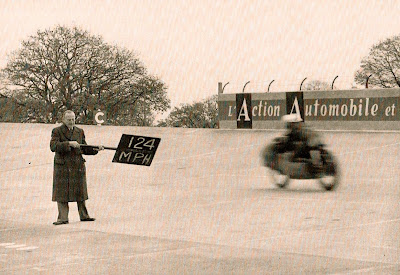
"
After that, Norton put the Kneeler aside. I had nobody there to support me and they felt it wasn't a real Norton."

Although Eric Oliver used the frame design as the basis for his World Champion sidecar outfit (to be copied by every other outfit shortly afterwards! See pic above), they refused to pursue McCandless' ideas further, and the Kneeler never raced again. Disillusioned, Rex McCandless turned to designing cars.
Photo credits:
Photos 1, 2, 3, 5 are from 'Sweet Dreams', by Gordon Small (Ulster Folk and Transport Museum, 1989). Sadly, out of print.
Photos 4, 10, and 15 are from Dark Davey Maertyn, Notorious Anglo-Cajun Photo Pyrate, Scourge of the Elektronyke Seas, Nemesis to the Evyl Muse Kopyryte, Drynker of Whysky, and Dryver of An Olde Pyckuppe Trucke.
Photo 6 (Triumph GP) is from Ivor Davies' 'It's a Triumph!' (Foulis, 1980). A transitional book; part 'Old School' publishing - the writing and small format - and part 'New Breed'; lots of great photos.
Photos 8 (first Featherbed)
and 15 (tank shot of Kneeler) are from Mick Walker's 'Norton; the Racing Story' (Crowood, 2002). Still in print; buy it!
The remainder of the Norton shots are from Mick Woollett's excellent 'Norton' (Osprey, 1992), which is also still available, and with George Cohen's 'Flat Tank Norton', is the best book written about this illustrious marque.






